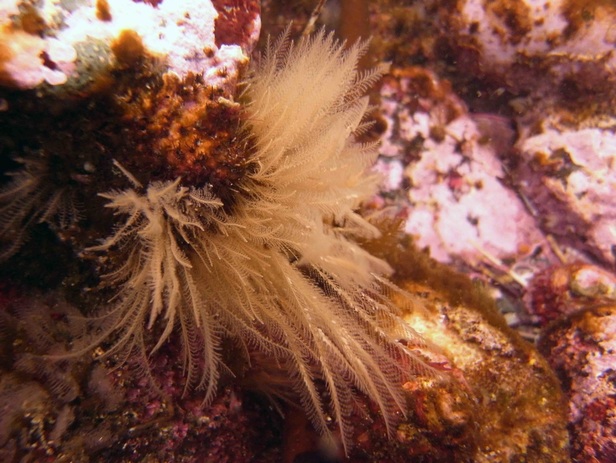Glassy plume hydroid, decorator hydroid, delicate plume hydroid • Plumularia setacea
Identification
This feathery hydroid colony reaches 15 cm tall. The main stems are unbranched and bear small, light-coloured globules. These globules are amphora-shaped (oval, narrowing into a tubular neck) reproductive polyps. The feeding polyps attach directly to the side-branches along just one side. The numerous side branches occur in the same plane, meaning the colony has a flattened structure.
Habitat & Range
Glassy plume anemone attaches to kelp stipes and holdfasts, rocks, and floats in the intertidal and subtidal to 133 m deep. In the Eastern Pacific its range extends from southern Alaska to northern Mexico; it is found in other oceans around the world as well.
Similar Species
Other feather-like hydroids are Aglaophenia spp. (larger) and Abietenaria inconstans (feeding polyps occur on both sides of branches).
This feathery hydroid colony reaches 15 cm tall. The main stems are unbranched and bear small, light-coloured globules. These globules are amphora-shaped (oval, narrowing into a tubular neck) reproductive polyps. The feeding polyps attach directly to the side-branches along just one side. The numerous side branches occur in the same plane, meaning the colony has a flattened structure.
Habitat & Range
Glassy plume anemone attaches to kelp stipes and holdfasts, rocks, and floats in the intertidal and subtidal to 133 m deep. In the Eastern Pacific its range extends from southern Alaska to northern Mexico; it is found in other oceans around the world as well.
Similar Species
Other feather-like hydroids are Aglaophenia spp. (larger) and Abietenaria inconstans (feeding polyps occur on both sides of branches).
References
Cowles, D. (2015). Plumularia setacea (Linnaeus, 1758). Invertebrates of the Salish Sea. Rosario Beach Marine Laboratory. Accessed 08/10/2015.
Lamb, A., and Hanby, B. (2005). Marine Life of the Pacific Northwest [electronic version]. Madeira Park, BC: Harbour Publishing.
Picton, B.E. & Morrow, C.C. (2015). Plumularia setacea (Linnaeus, 1758). Encyclopedia of Marine Life of Britain and Ireland. Accessed 08/10/2015.
Authors and editors of page
Kelly Fretwell (2015).
Cowles, D. (2015). Plumularia setacea (Linnaeus, 1758). Invertebrates of the Salish Sea. Rosario Beach Marine Laboratory. Accessed 08/10/2015.
Lamb, A., and Hanby, B. (2005). Marine Life of the Pacific Northwest [electronic version]. Madeira Park, BC: Harbour Publishing.
Picton, B.E. & Morrow, C.C. (2015). Plumularia setacea (Linnaeus, 1758). Encyclopedia of Marine Life of Britain and Ireland. Accessed 08/10/2015.
Authors and editors of page
Kelly Fretwell (2015).




